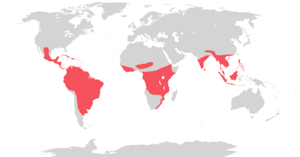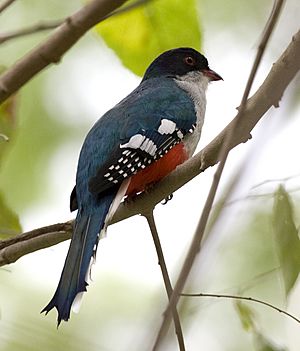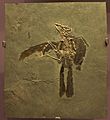Trogon facts for kids
Quick facts for kids Trogons |
|
|---|---|
 |
|
| A male red-headed trogon in Khao Yai National Park, Thailand | |
| Scientific classification |
|
| Kingdom: | Animalia |
| Phylum: | Chordata |
| Class: | Aves |
| Clade: | Cavitaves |
| Clade: | Eucavitaves |
| Order: | Trogoniformes AOU, 1886 |
| Family: | Trogonidae Lesson, 1828 |
| Genera | |
|
Apaloderma |
|
 |
|
| global distribution | |
Trogons and quetzals are amazing birds. They belong to a special group called an order, which is like a big family of birds. This order is named Trogoniformes. All trogons and quetzals are part of one family, the Trogonidae.
There are 39 different kinds, or species, of these birds alive today. They are grouped into seven smaller families called genera. The name "trogon" comes from a Greek word meaning "nibbling." This is because these birds nibble holes in trees to build their nests.
Contents
Where Do Trogons Live?
Trogons live in tropical forests all over the world. You can find most of them in places like Central and South America. This area has the most different kinds of trogons. There are 24 species from four different genera living there.
Three species of trogons live in Africa. These are part of the Apaloderma genus. In Southeast Asia, you can find twelve species. They belong to the Harpactes and Apalharpactes genera.
What Do Trogons Eat?
Trogons mostly eat insects and fruit. Their wide beaks are perfect for grabbing these foods. They have weak legs, which shows they spend most of their time in trees. They don't walk much on the ground.
Trogons can fly quickly, but they usually don't fly long distances. Most of them do not migrate, meaning they stay in the same area all year.
Unique Features of Trogons
Trogons have soft, often very colorful feathers. The males and females usually have different patterns and colors, which helps tell them apart. They are the only animals with a special toe arrangement called heterodactyl. This means two toes point forward and two toes point backward.
They build their nests by digging holes. They might dig into trees or even into termite nests. Female trogons usually lay 2 to 4 eggs. These eggs are often white or light-colored.
Images for kids
-
The Cuban trogon is one of two species restricted to the islands of the Caribbean
-
A male resplendent quetzal going into his nest.
See also
 In Spanish: Trogónidos para niños
In Spanish: Trogónidos para niños






